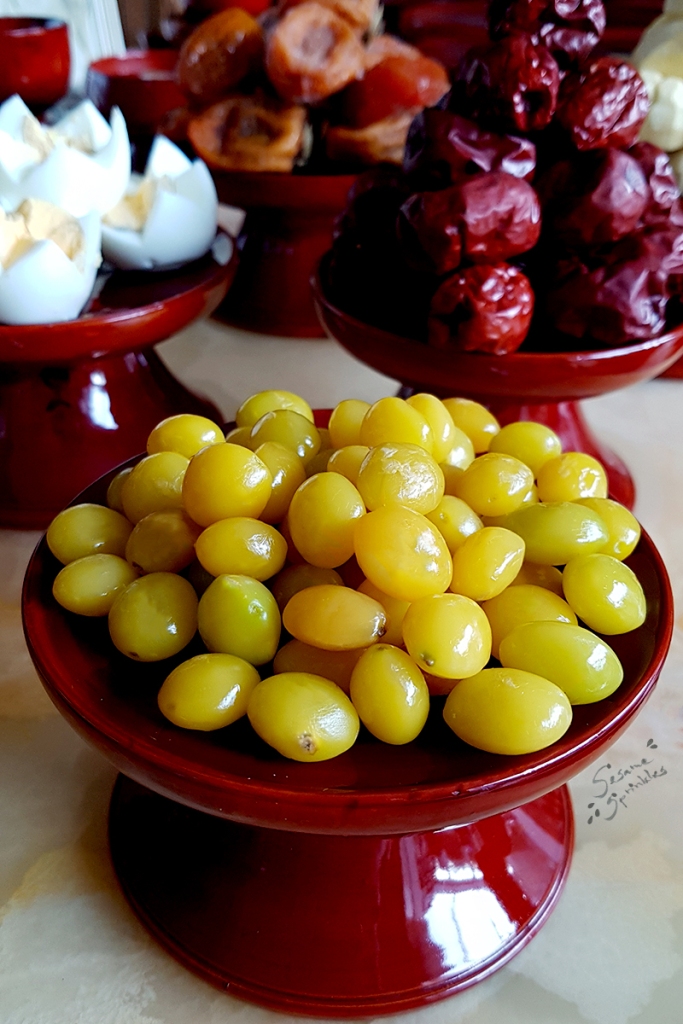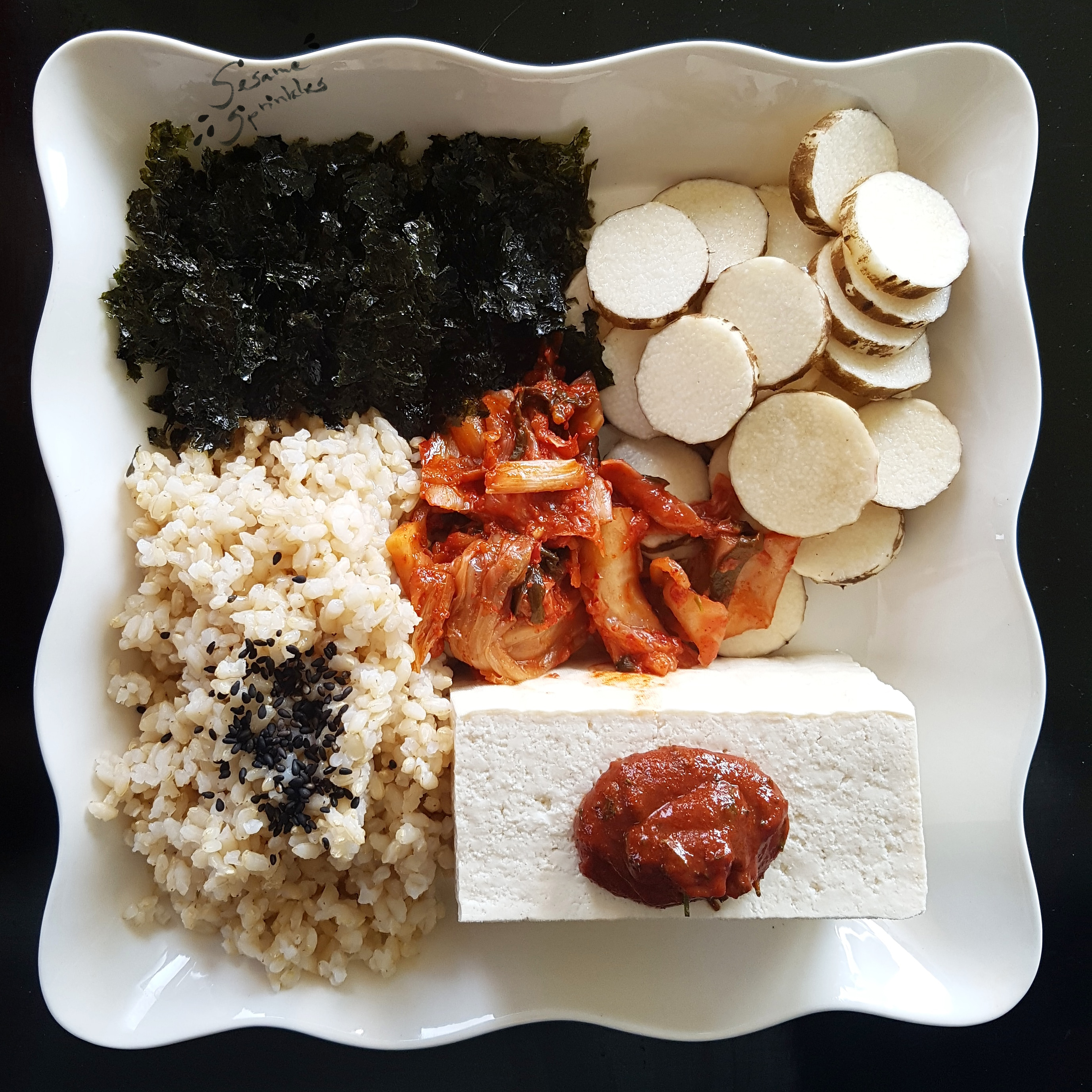[⚠️Warning: Graphic language may be included in the text below. Not advised to read when eating or sensitive to unappetizing descriptions. 🤬😱🤢]

I have a confession to make.
Years ago, I went on a treasure hunt. 🗺 In Germany.
The treasure were small, yellow gems. 💎 Those gemstones were enclosed in little pearls. ⚪️ And those pearls and gems were hidden inside marble-like balls, which had a golden color. 🔮
What am I referring to? Ginkgo seeds.
Previously, I had seen those jewel-like nuts on my early visits to Korea. And I had been lucky enough to get a taste of them. But they seemed rare and hard to find. In general, they were used sparingly – one single nut for each person at an entire meal. So when I heard how this precious food was retrieved, I wanted to do it myself.
In the neighborhood where I grew up, there were ginkgo trees planted on the roadside. And each year in fall, when leaves changed color and the fruits turned ripe, the street in front of our house was speckled with the ginkgo’s golden foliage. 🍂 But it also began to smell. Badly.
The foul odor came from the ginkgo fruits which dropped to the ground and were crushed underneath shoes and tires of whoever passed by. The smell of ripe ginkgo fruits is perceived differently by each person: While some people compare it to vomit 🤮, others find it reminiscent of sh***. 💩 As a matter of fact, the smell is caused by a chemical compound called butric acid, which is also found in rancid butter. 🤢 Everyone who has experienced either of those smells, knows it’s anything but appetizing. 🙊
In general, it is an unpleasant smell and your instinct tells you to stay away. Far away. Downwind if possible. 💨 Also, avoid stepping on the fruits. You might as well step in dog poo. 🐕💩
The strange fruit, however, has a nutty core which contains an edible seed! [I’ve always wondered who first attempted to touch that stuff. And then desire to EAT it.]
Anyhow, I set myself the goal to collect those nuts because I, too, wanted to eat them. But in order to do so, I had to get close to those stinky fruits and touch them myself. An embarrassing and unpleasant thought. Nothing a teenager would want to do in public.
“Need to be unrecognizable. Need to wait until no one is around.”
Those were the key concerns inside my head. I needed a plan and I needed equipment. So I first got myself disposable gloves* 🧤 and prepared a large scarf, hooded sweater as well as a hat to mask myself. 🧣🧢🥽 Then I waited until it was late at night. Between 2 AM and 3 AM was what I deemed an optimal time for my secret mission.
Eventually, hoping not to meet anyone, I stepped outside and into the darkness.
It was a cold October night. I wore a woolly hat, and I had wrapped the scarf around neck and head to cover as much of my face as possible. In addition to that, I pulled the sweater’s hood over my head to secure the disguise.
At the foot of a ginkgo tree, I crouched down and I poked around in the fruits that were lying on the ground. My fingers were busy crushing the smelly fruits and separating the hard core from the soft and juicy flesh. I collected the nuts containing the edible treasure inside a plastic bag.
But the smell was bad. Without the scarf covering my mouth and nose, the stench would have been overpowering. My hands, which were protected by plastic gloves, were cold. At the same time, however, my body was sweating.
I was nervous. Any sound I heard made me look around. I was paranoid. Once or twice, there was another soul who was outside at that time of night and walked past, eyeing me suspiciously. I felt like a criminal. [In retrospection, I probably just looked like a weirdo playing around with dog poop.]
When I had collected about a handful of nuts, I decided my mission was complete. I finally returned home with icy fingers and a bag filled with something that looked and smelled like puke. For the next hours, I stayed inside the bathroom, in front of the sink.
Washing my hands. Washing the seeds.
“Need to destroy evidence.” For some reason, those words kept flashing up.
So I washed and scrubbed diligently, trying to remove the slimy mass that clung to the seeds and caused the stench.
“No flesh may remain.” A voice whispered in my brain.
Before the break of dawn, I went to bed feeling exhausted and uneasy…
But my emotions had changed and self-esteem returned by the next morning:
I was proud of the adventure.
I had provided food for my beloved family.
I was looking forward to sharing the booty with my tribe.
When I presented the haul, I earned praise from my Korean father. And the comment that it was too little. And that I should do it regularly in the future. ………. [Is anyone here who has Korean parents and can relate???]
After all, my family and I enjoyed a Korean meal that day, and it featured a small dish of ginkgo seeds (sauteed and lightly seasoned with salt and sesame oil). Now that I finally knew how to retrieve the precious yellow seeds, I could get more any time. [That is, whenever I felt like going through all that trouble again!]
By telling you this looong story, I admit I committed this deed. I did this awkward and creepy thing. There. I said it now. I confessed. 🙈

What are ginkgo seeds? How do you eat them?
For people who grew up in East Asia, the process of harvesting ginkgo may be less shocking or disturbing than above personal experience. Ginkgo seeds, which are called eunhaeng (은행 銀杏 / 은행씨 eunhaeng-ssi / 은행알 eunhaeng-al) in Korean,** are consumed for example in Korea, China and Japan. 🇰🇷🇰🇵🇨🇳🇹🇼🇯🇵 Ginkgo biloba, which is its scientific name, is in many regards a fascinating plant! [Keywords: living fossil, gender, resistances to air pollution and diseases, old age, human culture and more…]
Regarding its culinary aspects, ginkgo seeds are edible after being heated until they are translucent.
The flavor of the seeds is subtle yet complex: They have a characteristic smell which is (thankfully) very different from the surrounding fruit. The taste is slightly bitter and nutty, while the texture of the cooked seed is rather soft and chewy.
In Korean cuisine, they are usually fried in a little bit of oil, steamed, or cooked with rice and in soups. The bright yellow seeds are nutritious, but they also catch the eye and thus simultaneously serve as decoration. Common dishes featuring ginkgo seeds are for example rice steamed inside lotus leaves (Yeonnip-bap 연잎밥), Yakbap (약밥) or nourishing soups. Sometimes, roasted ginkgo seeds (eunhaeng gu-i 은행구이) can also be found as street food – in small cups or on a skewer! 🍡






Where can you get ginkgo seeds? How to find ginkgo?

Ginkgo trees produce ginkgo fruits. However, there are female and male trees which need to grow close enough to each other, so that the female ginkgo can be pollinated and develop fruits.
These fruits fall to the ground when they are mature. To acquire the edible seeds, the ginkgo nuts need to be separated from their fleshy part (sarcotesta) first. There are various strategies for removing the smelly coating, e.g. by burying the whole fruits in the ground and waiting until the flesh has rotten away. ☠️ This method, however, requires time and ground for digging. ⛏ [You’re literally burying the treasure!] Alternatively, since the ripe fruits are very soft, the nuts can be simply squeezed out. The leftover flesh is removed by washing and scrubbing the ginkgo nuts as mentioned above.


Next, the hard shell of the ginkgo nuts needs to be opened – this can be done for example with a regular nut cracker. The seed inside is covered by another layer of papery-thin skin, which peels off when heating the seeds. Due to the heat the ginkgo seeds also change their color from milky green-yellowish to a translucent shade of yellow or green. Once they are cooked through, ginkgo seeds are edible.
If you happen to live in an East Asian country, there are more convenient ways than picking up ginkgo seeds from the roadside! In Korea, ginkgo seeds can be found in supermarkets and on traditional markets when they are in season. Since the fruits ripen in fall, fresh nuts are normally available between October and the beginning of spring. You can find ginkgo nuts or shelled ginkgo seeds inside a store’s fridge. Buying the peeled seeds is a bit expensive, but it saves a lot of manual work and time!
Last but not least, before you go off to collect ginkgo seeds yourself and eat them by the handful [because you know how to get them for free now], a few words of caution: ⚠️Eating large quantities of ginkgo seeds is not advised. ⚠️ Beside its peculiar taste, ginkgo is also consumed because of its nutritional value (37.8 % carbohydrates, 4.3 % proteins, 1.7 % fat) and certain ascribed medicinal properties. 💊 Too much of it, however, may have poisoning effects. So please enjoy in moderation! 💚💛🧡 [It remains a special treat after all that work. 😉]

.
.
Additional notes from the author
- *) It is generally suggested to wear gloves when handling ginkgo fruits, because substances inside the flesh can cause allergic reactions. ⚠️
- **) The Chinese name for ginkgo is 銀杏 or 银杏, which is read as yínxìng in Mandarin. The Japanese pronunciation of the same characters, on the other hand, is ginkyō (ギンキョウ) or ichō (イチョウ).
- Ginkgo is occasionally also spelled “gingko”.









Enjoyed reading your venture, Bonnie. You are brave to tackle such unusual task. I love the taste of ginko nuts but seldom have opportunities to eat. They are delicacies for special occasions.
Thanks for sharing 💚🧡🍂
LikeLike
Thank you for that comment, dear Kim! 😊
I assume you don’t have any ginkgo trees growing in vicinity then… Good for your nose! 😆
LikeLike